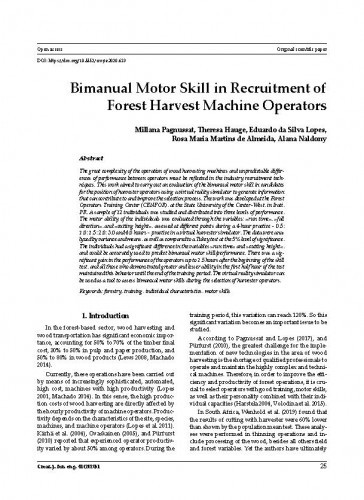The great complexity of the operation of wood harvesting machines and unpredictable differences of performance between operators must be reflected in the industry recruitment techniques. This work aimed to carry out an evaluation of the bimanual motor skill in candidates for the position of harvester operators using a virtual reality simulator to generate information that can contribute to and improve the selection process. The work was developed at the Forest Operators Training Center (CENFOR), at the State University of the Center–West, in Irati, PR. A sample of 12 individuals was studied and distributed into three levels of performance. The motor ability of the individuals was evaluated through the variables: »run time«, »fall direction«, and »cutting height«, assessed at different points during a 4-hour practice – 0.5; 1.0; 1.5; 2.0; 3.0 and 4.0 hours – practice in a virtual harvester simulator. The data were analyzed by variance and means, as well as compared to a Tukey test at the 5% level of significance. The individuals had a significant difference in the variables »run time« and »cutting height«, and could be accurately used to predict bimanual motor skill/performance. There was a significant gain in the performance of the operators up to 1.5 hours after the beginning of the skill test, and all those who demonstrated greater and lesser ability in the first half hour of the test maintained this behavior until the end of the training period. The virtual reality simulator can be used as a tool to assess bimanual motor skills during the selection of harvester operators.
Sažetak

 Croatian journal of forest engineering : 41,1 (2020) : journal for theory and application of forestry engineering / editor-in-chief, glavni urednik Tibor Pentek, Tomislav Poršinsky.
Croatian journal of forest engineering : 41,1 (2020) : journal for theory and application of forestry engineering / editor-in-chief, glavni urednik Tibor Pentek, Tomislav Poršinsky.